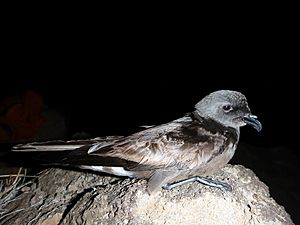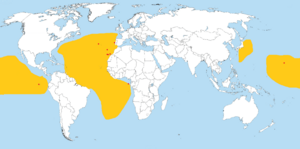Band-rumped storm petrel facts for kids
Quick facts for kids Band-rumped storm petrel |
|
|---|---|
 |
|
| Conservation status | |
| Scientific classification | |
| Genus: |
Hydrobates
|
| Species: |
castro
|
 |
|
| Synonyms | |
|
Oceanodroma castro |
|
The band-rumped storm petrel, also called the Madeiran storm petrel or Harcourt's storm petrel, is a small seabird. Its scientific name is Hydrobates castro. It is part of the storm petrel family, known for flying low over the ocean.
Contents
What Does the Band-rumped Storm Petrel Look Like?
This storm petrel is about 19 to 21 centimeters (7.5 to 8.3 inches) long. Its wingspan is around 43 to 46 centimeters (17 to 18 inches). It weighs about 44 to 49 grams (1.5 to 1.7 ounces).
Most of its body is brownish-black. It has a large white patch on its lower back, called the rump. This bird looks a bit like the Leach's storm petrel. Both have a tail that splits at the end, like a fork. They also have long wings.
However, the Leach's storm petrel has a deeper forked tail. Its white rump is shaped more like a 'V' or a triangle. The Band-rumped storm petrel's flight is smoother, like a shearwater. The Leach's storm petrel flies more like a tern, with quick, bouncy movements.
Where Do Band-rumped Storm Petrels Live?
These birds breed on islands in warmer parts of the Atlantic Ocean and Pacific Ocean.
In the Atlantic, you can find them on islands like:
- The Berlengas (near Portugal)
- The Azores
- Madeira
- The Canary Islands
- Saint Helena
In the Pacific, they breed off eastern Japan. They also live on Kauai and Hawaii in the Hawaiian islands. Another breeding spot is the Galápagos Islands. In 2018, they even started breeding on the Mauna Loa volcano on the island of Hawaii.
How Do Band-rumped Storm Petrels Behave?
Breeding Habits
Band-rumped storm petrels nest in groups, called colonies. They choose rocky places near the sea. Females lay just one white egg at a time.
These birds spend the time when they are not breeding out at sea. When they are at their nesting sites, they only come to land at night. This helps them avoid predators like gulls and birds of prey such as peregrine falcons. They even try to avoid landing on bright, moonlit nights. Like most petrels, they are not very good at walking. They can only shuffle short distances to and from their nests.
What Do They Eat?
Band-rumped storm petrels find their food by picking items off the water's surface. They eat small sea creatures without backbones, like invertebrates. They also eat small vertebrates (animals with backbones) and sometimes dead animals, called carrion.
Scientists once studied how well these birds could dive. However, that study was actually done on a group of these birds from the Azores. Later, scientists realized that group was a different species entirely!
Understanding Band-rumped Storm Petrel Types
Scientists have found something interesting about these birds. There are "cold season" and "warm season" groups. These groups use the same nesting spots but at different times of the year. They also have different calls and change their feathers at different times.
This suggests there might be two "hidden species" that look very similar. After studying their DNA, the "warm season" group in the Azores was officially named a separate species. It is now known as Monteiro's storm petrel.
This bird was once placed in a different group, called Oceanodroma. But now, scientists have decided that group should be combined with Hydrobates.
See also
 In Spanish: Oceanodroma castro para niños
In Spanish: Oceanodroma castro para niños



